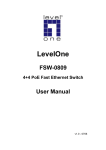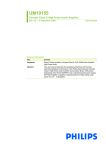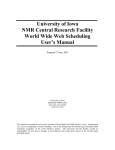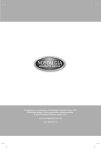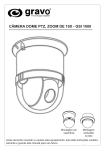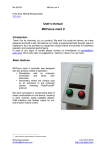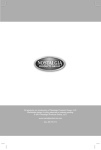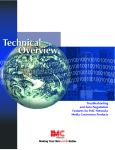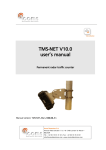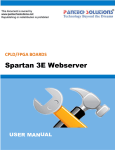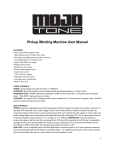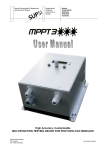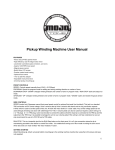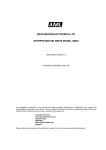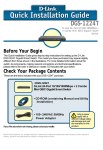Download Micro-Step Driving for Stepper Motors: A Case Study
Transcript
Micro-Step Driving for Stepper Motors: A Case Study N. Sedaghati-Mokhtari Graduate Student, School of ECE, University of Tehran, Tehran, Iran n.sedaghati @ece.ut.ac.ir Abstract: In this paper, a case study for implementation of the micro-step driver optimized for resonance frequencies of the stepper motors is presented. First of all, the motor driver is implemented in Full- and Half-step modes. According to the irregular torque-to-rotation curve in these modes, several optimizations are applied to the driver achieving the micro-step driving circuit. Driver circuit is verified for each modes of motor motion. Considering obtained results, torque-reduction in resonance frequencies (appeared as holes in torque curve at these points) is eliminated with micro-step driving. By this optimization, and in the micro-step driving mode, motor consumes lower power than other modes. Keywords: Stepper motors, Micro-step driving. 1 Introduction Steppers are special motors that do not have any commutator to reverse flow of the windings current. Stepper motors are the best alternatives for applications that high-accuracy motions are required such as CNC, printers and so on. Because of the simple winding and control system, the main applications of these motors are the motion controls. On the basis of the motor structure and operation, stepper motors are divided into three types: permanent magnet (PM), variable reluctance (VR) and hybrids. There is special procedure for driving each of them. In general, stepper motors are driving in full-, halfand micro-step modes. In full-step mode, to change rotor position completely, activation and deactivation signals are fed to the windings alternatively in each cycle. In half-step, each winding can stay activated for more than one cycle. Therefore, the rotor motion is half of the full-step and the motor resolution is two times more. Micro-step driving is another alternative for motor motion that has more accuracy and continuous motion. Two main advantage of microstep mode is the possibility for rotor to move between full and half modes and to eliminate irregular characteristics of motor torque. In this paper, stepper motor driver circuit implementation process for all three modes is presented. For design testing, appropriate driving signal patterns are generated using PC parallel port. Torque tests are applied to the driver circuit and experimental results extracted. As obtained, using micro-step driving, stepper motor rotates more continuously. Also, irregular torque values (appeared like holes in torque curve at resonance frequencies) are eliminated. This paper is organized as follows: in section II, existing stepper motor control and driving techniques are studied. In section III, current control methods for stepper motors are described. Full- and half-step implemented circuit is presented in section IV. Micro-step driving and its appropriate implementation, simulation, and test results appeared in section V and the paper is concluded in section VI. 2 Stepper Motor Driving and Control Generally, control and driving techniques for stepper motors are categorized in open- and closeloop modes (here, open-loop mode is considered). In stepper motors, driving is done by activation and deactivation of various windings. In general, stepper motor driver circuit is divided into two main parts: signaling and switching. Signaling part is for generating the consequent and regular pulses (patterns) for motor driver. The switching part turns the control switches on and off according to the generated patterns. A four-phase stepper motor driver has two main parts as follows: control signal sequencer and motor driver (Fig 1). • Forward: only A and D switches are closed. • Reverse: only B and C switches are closed. • Fast Decay: All switches are closed and the winding current decreased through the power supply and diodes path. This mode doesn’t damage the winding and therefore the rotor can move freely without any resistance. step commands • Slow Decay: In this mode, the current is passed through the motor winding rotationally without any resistance. Therefore, if a few current remains in winding, this operation caused the current dissipated and the rotor stopped slowly. Ph1 Control Signal Sequencer 2 Motor Driver 3 direction commands Motor 4 Activation Currents Control Signals Fig. 1. Stepper motor driving system. According to the nature of the windings, the current and therefore the switch state could not change suddenly except that infinite opposite voltage is applied to the winding. When the control switch of the winding is closed, the winding current increased gradually. Thus, when its state change (the switch opened), large voltage is applied to the winding. This may damage the control switches if there is no care about it. There are two main strategies to solve these problems: using diode or capacitance in parallel with the winding. There are several driving techniques for every type of the stepper motors. Consider a bipolar H-Bridge hybrid motor, as shown in Fig2. Reversing the magnet field direction, one can change the winding current flow. Achieving this, one can arrange the control switches like H letter (called H-Bridge) and put the winding between them. +S upp ly It is possible that activation of control switches in H-Bridges caused short-circuit between power supplies (i.e. closing switches A and B). In these cases, usually logic gates used to eliminate shortcircuit effects. Fig 3 shows the sample circuit where this technique is applied. +Supply X B D Y As shown above, all of the operation modes can be accessible only with a few numbers of signals. This is so practical when we use microcontrollers or microprocessors for control signal (pattern) generation (i.e. X and Y signals on the above). Stepper Motor Current Control C Control B C Fig. 3 short-circuit elimination for H-Bridge structure 3 A A D Fig. 2. H-Bridge structure Because of four control switches, H-Bridge can have 16 different modes of operations. Some of them are not used generally. Some of the practical operation modes are as follows: Small stepper motors generally have a small DC supply that control the winding current and limited with the resistance of the winding. At the other hand, motors with the huge torque values have a winding with small resistance. Therefore, they require current limitation and controlling systems (as external circuits). One of the simplest ways to limit the current of the winding is to put the resistance serially with the winding. This is called resistive approach. Another alternative is to use the mixed of the resistance and transistor for current limiting. In this way, rise and fall times of the current will be less than the resistive method. This method also called linear approach. In these two ways, the current is only depends on winding reluctance and the supply voltage. When the current increased, the winding voltage and current decreased. Therefore, the current can not arrive to its maximum threshold. Another current control approach for stepper motor is the open-loop method. At the previous approaches, the motor current is automatically limited and therefore caused the power to be dissipated more and more. There are two solutions for this bottleneck. First, assume the time diagram for winding voltage characteristics though the time. While the motor current is below the normal value (threshold), all the supply voltage is applied to the winding. When the current is reached to the threshold value, the voltage is dropped to the value that can keep the motor current to its normal value. The second solution is to use power supply generator with two different voltage levels that applied to the winding alternatively. One can use the power supply controlled with Pulse Width Modulator (PWM) chopper to control the current. In this method, while the motor current is increasing, the control system applies the supply voltage to the motor. When the current is reached up to the threshold, the control system tries to fix the current to the ideal value by changing the supply pulse durations. (As shown in Fig4) For each chopper, the supply pulse duration (D) is defined as follows: D = Ton / (Ton + Toff) where the Ton and Toff are switch activation/deactivation times. As shown in Fig.4, supply voltage in the chopper cycles, that switches are closed (on), applied to the winding. But the negative voltage is applied when the switches are open. The main problem with this method is its open-loop characteristic. Fig. 4. PWM operation Solution for this bottleneck is to use the feedback path and monitor the current to determine when the switches should be opened and when they should not. This method is also called One-Shot Feedback current control. In this method, when the winding current is increased greatly, the winding becomes inactive for fixed time. This method requires Onshot controller and the current sensing modules. The One-Shot controller is shown at Fig 5. Fig. 5. One-Shot controller When the one-shot output (~Q) is low, voltage across the R1 caused the winding current compensated. Thus, one-shot controller should not be too sensitive to comparator output because the chopping rate becomes variable. In the Linear method, when the switches were closed, supply voltage completely applied and the chopping only performed when the motor current reach the threshold (Vref) value. In some application, one can use one-shot controller in H-Bridge structure thus the H-Bridge controller will be made (As shown in Fig 6). In this work, combination of H-Bridge and one-shot controller used for motor driving and the current limiting methodologies. used to generate the pulse rate. The L298 chip is dual H-Bridge driver that work with high voltage and current. This driver converts the TTL logic levels to the signal levels that can drive relays, solenoids, DC and stepper motors. By combining the L297 as the motor controller and current limiter and L298 as dual H-Bridge driver, full stepper motor driver system can be performed. The step and direction data is received form the microcontroller system to the L297 and the control signals are generated for L298. These signals used to drive the stepper motor for specific steps determined with the steps number. The minimum system that is performed by above components is shown in Fig 7. Eight diodes are fast diodes and hold the supply voltage level for motor windings in +V value. R4 and R5 resistors are current sensors and can enable the appropriate signals if the motor current exceeds to the threshold value. When the voltage of sense resistors reaches to the Vref, the winding is disabled and the diodes offload the winding current. This operation continues while the internal oscillator set the stop command. The chopper rate is determined with the RC network connected to the OSC input. Fig. 6. One-shot Controller in H-Bridge structure 4 Normal driving circuit (Full- and Half-step) As shown in the previous sections, stepper motor driver system is formed by signaling and switching parts. One of the practical approaches for implementation of such a system is of-the-shelf design where existing components combined and construct the whole system on the board. The main components are L297 chip [3] for signaling and current control and L298 [4] for switching the motor. The L297 chip contains the control system for uniand bipolar motors. It also contains two separate PWM chopper for current control whereas each chopper contains comparator, flip-flop and the external sense resistor. One internal oscillator also +5 +5 VS EN Enable Reset RST Half/Full HALF Step CW Home HOME Sync SYNC VSS +VS A IN1 B IN2 OUT1 C IN3 OUT2 IN4 OUT3 D CLK Direction +V L297 L298 INH1 ENA INH2 ENB To the motor windings OUT4 SEN1 CON SEN2 OSC Vref GND C1 SA GND SB R2 R4 R5 R3 R1 +5 Fig. 7. Minimum system for stepper motor driver using L297 and L298 5 Micro-step driving circuit In micro-step mode, the resolution (number of steps per round) is increased. The motor used in this work pass 1.8 degree per rotation and has resolution equals to 200 steps. After micro-step driving, the target becomes 800 steps per rotation (4 micro-steps per each step). After driver implementation for half- and full-step modes, several parts should be changed and optimized for micro-step driving. One of the main parts is the reference voltage (Vref). Another optimization is to control two phase of the motor independently. For this purpose, driver circuit must be changed to be able to control the winding current independently to the portion of the final phase current. For this, one can control the current of the motor phases to be able to move between two full steps more. According to this, digital to analog converter (DAC) and operational amplifiers (OpAmp) are used to control the reference voltage of the motor. Inputs to the ADC will determined the signal levels and the bit number can perform more accurately. Two L297 devices are used to control the L298 phases separately. These devices should be synchronized by each other. The inhibit output signals of each L297 (INH) control corresponding enable (EN) lines of the L298 (ENA and ENB). The extra part of the minimum system (shown in Fig 7) is shown in Fig 8. 4 In this work, Oriental motor with 12v supply voltage and maximum 420 mA working current is used. Torque test system is shown in Fig 10. In every round of the motor with determined rpm value, the maximum calculated number in the dynamometer is recorded. There are values determine the maximum motor power for appropriate rpm numbers. dynamometer Motor Fig. 10. Stepper motor torque test system. POW(-15V) From uController VCC 2k2 2k2 Data C OUT OUT CMPN THSLD REF + REFDAC0800 104 1k+2k2 LF353 Experimental Results To Vref of the L297 POW(15V) Fig. 8. Extra part for micro-step driving. a) Top-view Also, the implemented printed circuit board (PCB) of the system is shown in Fig 9 ((a) for top and (b) for bottom view). The motor torque is calculated for each three modes of the motor motion and the extracted results represented in Fig 11 to Fig 14. It must be expressed that the motor power value is converted to the Newton unit and then comparison is done. 5 Conclusion In this work, implementation of the stepper motor driver in three full-, half- and micro-step modes are presented. Torque test are applied to all of the driver circuits and the motor torque according to its rpm value is extracted. As mentioned, after optimizing driver circuit for micro-step driving mode, all of the irregular torque-to-rotation values in the curve (appeared as holes) in the full- and half-step modes eliminate and regular curve is performed. After applying test to the circuits, it has been determined that torque-reduction in resonance frequencies is eliminated with micro-step driving and motor power consumption becomes less than other modes of operations. b) Bottom-view References Fig. 9. Printed Circuit Board (PCB) of the system. [1] Online documents: http://www.epanorama.net [2] Online documents: http://www.cs.uiowa.edu [3] L297 user manual at: www.alltronics.com [4] L298 user manual at: www.st.com [5] LMD18245 manual: http://ww.national.com [6] Akira Sugawara, Takashi Kenjo, “Stepping Motors and Their Microprocessor Controls”, Oxford University Press, 1995. Fig. 11. Full-Step mode Torque to rpm Fig. 12. Half-Step mode Torque to rpm Fig. 13. Micro-Step mode Torque to rpm Fig. 14. All modes Torque to rpm






